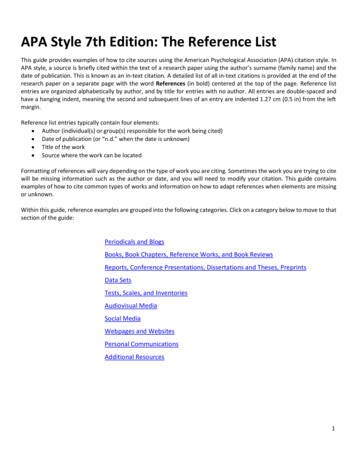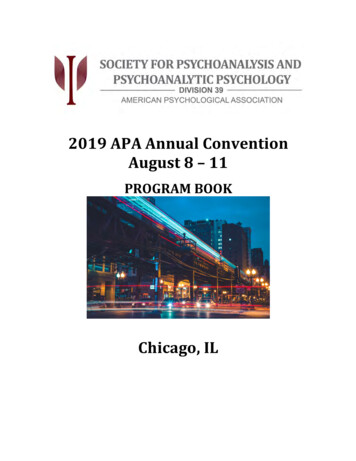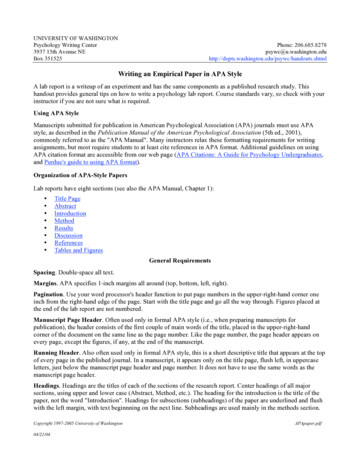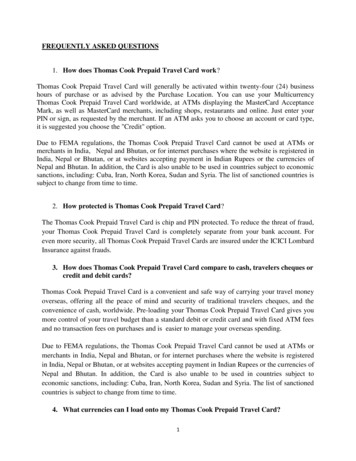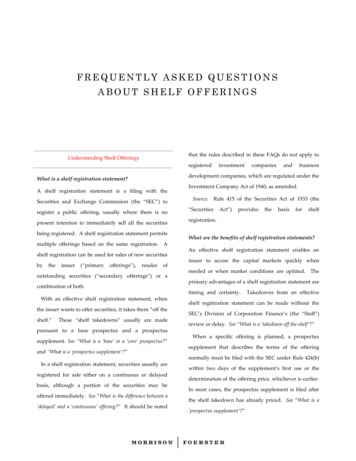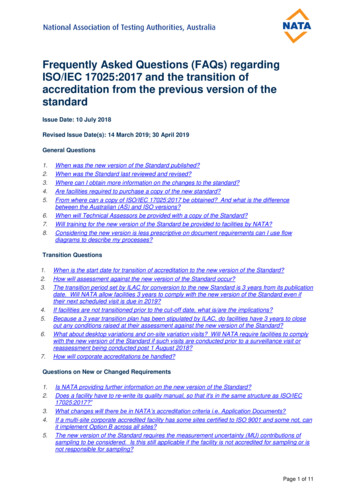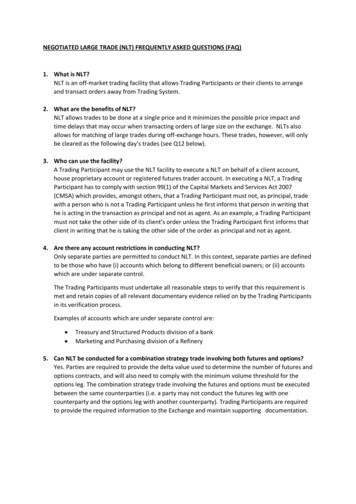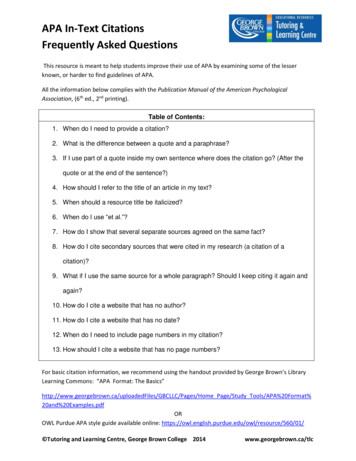
Transcription
APA In-Text CitationsFrequently Asked QuestionsThis resource is meant to help students improve their use of APA by examining some of the lesserknown, or harder to find guidelines of APA.All the information below complies with the Publication Manual of the American PsychologicalAssociation, (6th ed., 2nd printing).Table of Contents:1. When do I need to provide a citation?2. What is the difference between a quote and a paraphrase?3. If I use part of a quote inside my own sentence where does the citation go? (After thequote or at the end of the sentence?)4. How should I refer to the title of an article in my text?5. When should a resource title be italicized?6. When do I use “et al.”?7. How do I show that several separate sources agreed on the same fact?8. How do I cite secondary sources that were cited in my research (a citation of acitation)?9. What if I use the same source for a whole paragraph? Should I keep citing it again andagain?10. How do I cite a website that has no author?11. How do I cite a website that has no date?12. When do I need to include page numbers in my citation?13. How should I cite a website that has no page numbers?For basic citation information, we recommend using the handout provided by George Brown’s LibraryLearning Commons: “APA Format: The BCLLC/Pages/Home Page/Study Tools/APA%20Format%20and%20Examples.pdfOROWL Purdue APA style guide available online: / Tutoring and Learning Centre, George Brown College 2014www.georgebrown.ca/tlc
APA In-Text CitationsFrequently Asked Questions1.When do I need to provide a citation?You should provide an in-text citation whenever you quote, paraphrase or summarize researchand ideas that are not your own. This may include theories, best practice guidelines, and ofcourse, statistics.You should also cite whenever you present a fact that is not common knowledge. This meansthat if the general public would not be aware of the fact, it should be cited.For example:General Knowledge (No citation necessary)The flu is an airborne virus.Fact from a resource (citation necessary)The drug Tamiflu was developed by acompany named Roche following an outbreakof H5N1 in China (Grice, 2007)The rule of thumb is usually: when in doubt, cite.Generally, you should provide a citation for any information that you didn’t already know beforetaking the class or program you are writing for. So even if the information came from a text,lecture, or handout in class, rather than an article or textbook, you should still try to provide acitation to show that you are basing your arguments on facts, rather than guesses, rumours, orassumptions.2.What is the difference between a quote and a paraphrase?It’s very important to recognize the difference between quoting and paraphrasing. If you use thesame phrases or words without properly citing your source, this is considered plagiarism, andyou could lose marks, or even get a zero.In addition, make sure that you paraphrases are true paraphrases and not patch-writing.Original:Canadian students have become very familiar with exhaustion due to many competing lifedemands; exhaustion has become a way of life for them.A quote is the exact words from asource included in your own writing; aquote is always surrounded byquotation marks. In his article, Peterson (2014) states that,“students have become very familiar withexhaustion; it has become a way of life forthem” (p. 45)A paraphrase gives the informationfrom the source but entirely in yourown words, not the words of theauthor. One study (Peterson, 2014) shows thatstudents in Canada struggle to manage theirworkload and live a balanced lifestyle.Patch-writing is when we take somephrases of the original and mix it withour own words without providingproper quotes. (This is plagiarism) Students in Canada are familiar with exhaustionbecause of many competing life-demands. Tutoring and Learning Centre, George Brown College 2014www.georgebrown.ca/tlc
APA In-Text CitationsFrequently Asked Questions3.If I use part of a quote in my own sentence where does the citation go? After the quote orat the end of the sentence?When you use a quotation mid-sentence, end the quote with quotation marks and cite thesource in parentheses immediately after, and continue the sentence. If the author’s name andthe date of publication are included before the quotation, then provide only the page numbersimmediately after the quotation.Example:As the 6th Edition of the APA Manual (2010) states, it is important to, “cite the source inparentheses immediately after the quotation marks” (p.171), even if the sentence continues.4.How should I refer to the title of an article in my text?Use quotation marks around the title of a shorter texts, such as an article or chapter, whenreferring to it in-text.Example:In Potterson’s (2013) article, “Nursing in a changing society,” she argues that 5.When should a title be italicized?All titles of longer or complete texts, such as books, periodicals, films, videos, TV shows, andmicrofilm publications are italicized in APA formatting.Example:Potterson’s (2011) book, Nursing in Canada, details the history of the nursing occupation inCanadian society and how it came to be what it is today.6.When do I use “et al.”?There are two circumstances in APA style when you use “et al.”1) Use “et al.” when a work has six or more authors. Include the first author’s namefollowed by “et al.”If a source listed its authors as: Bogdon, H., Halburd, R., Masterson, P., Preston, S.,Ulwig, Z., & Bloom, O. (2012)., include only the surname of the first author followed by“et al.”Example: (Bogdon et al, 2012)2) Use “et al.” when citing a work multiple times which has three, four, or five authors. Inthe first citation, list all of the authors. In the following citations, list only the surname ofthe first author followed by “et al.” and the date.Example: The first study (Bogdon, Halburd, & Masterson, 2013) demonstrated findingsthat differ from commonly held beliefs. The study (Bogdon et al., 2013) showed that Tutoring and Learning Centre, George Brown College 2014www.georgebrown.ca/tlc
APA In-Text CitationsFrequently Asked Questions7.How do I show that several separate sources agreed on the same fact?Include all authors’ names, listed alphabetically, and the dates of the works in the sameparentheses. Separate the citations with semi-colons (;).Example:(Lewis, 2000; Miller & Seacrest, 1990; Norton, 2011)8.How do I cite secondary sources that were cited in my research (a citation of a citation)?Name the original work in-text and add the original date of publication in parentheses after theauthor’s name. Provide the secondary source information in parentheses at the end of thesentence with the words “as cited in.”In-text citation example:Choi’s (2005) research indicates that fog can make some people feel calm and at ease (as citedin Pitt, 2009).Provide only the secondary source in the reference list.Reference entry example:Pitt, B. (2009). Male celebrities: Toil and trial. Los Angeles, CA: Great Publishing Incorporated.9.What if I use the same source for a whole paragraph? Should I keep citing it again andagain?Basically, you need to make sure that it is clear in each sentence, where the information is from.When writing a paragraph that refers to the same source several times, there are 3 options forformatting in-text citations, but you can use a combination of these.1) When the author’s name is written in the narrative, include the date in parentheses onlythe first time after the author’s name is mentioned.Example:Similarly, Clark’s study (2013) demonstrated that walking for 20 minutes every daycould improve people’s health. Clark urges people to consider how they could integratemore walking into their own lives.2) If the author’s name is included in the parenthetical citation with date, then include thecitation every time you reference the source in the paragraph.Example:One study in particular (Clark, 2013), demonstrated findings that were different from therest. This study (Clark, 2013) explored the relationship between fruits and vegetables.3) When both the date and the author’s name are stated in-text, do not include anyparenthetical information.Example:In 2013, Clark observed that a large number of students struggled with balancing theirschool work and their personal lives. Clark suggests several reasons for this. Firstly, Tutoring and Learning Centre, George Brown College 2014www.georgebrown.ca/tlc
APA In-Text CitationsFrequently Asked Questions10. How do I cite a website that has no author?If there is no personal, corporate or organizational author provided on the website, use the titleof the webpage in-text or the first few words of the title in parentheses. In both cases, the titleshould be in quotations.Example:“Apes in their natural habitat” (2014), suggests that many apes live longer in the wild than incaptivity Example:Research shows that many apes survive longer in the wild than in captivity (“Apes in theirnatural habitat,” 2014).11. How do I cite a website that has no date?If there is no date provided on the webpage, use the abbreviation “n.d.” (stands for “no date”)instead.Example:Johnson & Johnson (n.d.) celebrate the fact that Example:One extensive study (Johnson & Johnson, n.d.) demonstrates that 12. When do I need to include page numbers in my citation?In APA style, always provide a page number for a direct quotation and for statistics wheneverpossible.Example:In his article, Peterson (2014) states that, “students have become very familiar with exhaustion;it has become a way of life for them” (p. 45).The APA Manual also encourages writers to provide a page or paragraph number whenparaphrasing specific material from a source, but it is not always required. Ask your teacher ifthey would prefer page numbers for all references.13. How do I cite a website that has no page numbers?If no page numbers are available, include paragraph numbers instead (para. #). If no paragraphnumbers are available, you can count paragraphs starting at the top of the document andmoving downwards.Example:(Alderdice, 2014, para. 2) Tutoring and Learning Centre, George Brown College 2014www.georgebrown.ca/tlc
Potterson’s (2011) book, Nursing in Canada, details the history of the nursing occupation in Canadian society and how it came to be what it is today. 6. When do I use “et al.”? There are two circumstances in APA style when you use “et al.” 1) Use “et al.” when a work

